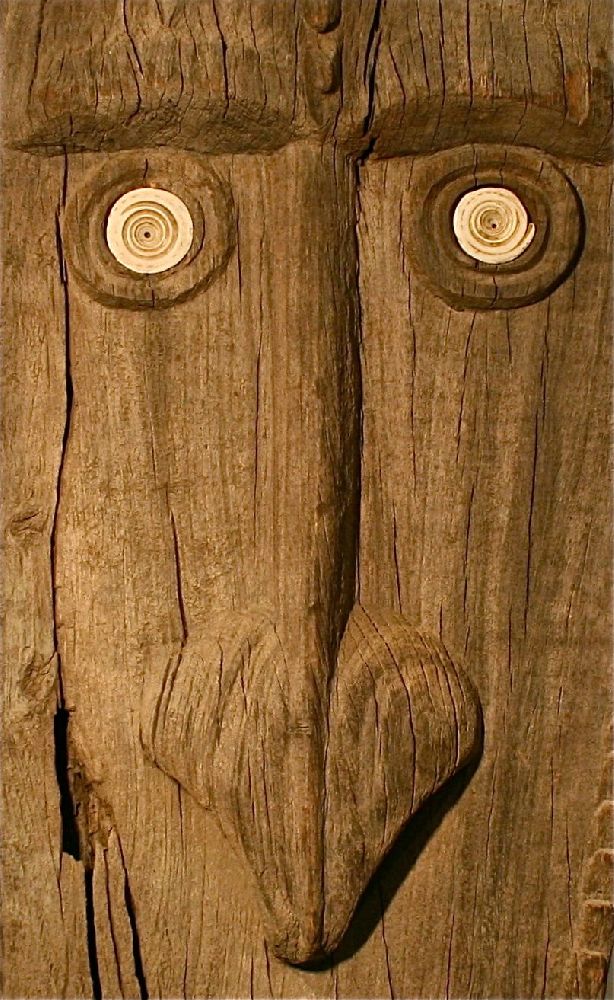

Title: Papua New Guinea Ceremonial House Hand Carved Wooden Roof Posts
Shipping: $300.00
Artist: N/A
Period: 20th Century
History: Art
Origin: N/A
Condition: Museum Quality
Item Date: 1960
Item ID: 4839
A magnificent pair of hand-carved spiritual headhunting supporting posts in a men's ceremonial house. Originating from the Wongam Village, Watam Lagoon, Middle Sepik, Papua New Guinea, and created by the Iatmul People, these museum-quality wooden roof supporting posts not only provide structural support but also bear totemic symbols representing the owning clan. These impressive posts, collected in 1960, are more than a century old, showcasing the rich cultural history of Papua New Guinea. Crafted with a jade stone hatchet by the village inhabitants, the ironwood posts feature intricate carvings, including a striking connection between the ancestor and the crocodile. The human face adorned with a long-scaled tongue licking a head, seamlessly transforms into a crocodile body, emphasizing the symbolic significance. Mounted on custom-made metal stands, these majestic posts boast shell eyes and hand-carved ironwood, adding to their artistic appeal. However, obtaining such artifacts in the present day poses challenges due to concerns about bugs infesting the rare wood. In the United States, the risk of invasive species damaging crops hinders the importation of these exquisite pieces. Those fortunate enough to import such wood face a prolonged process, with a waiting period of six months to a year before receiving approval to introduce it into their environment. In essence, these hand-carved posts not only serve as architectural supports for the Men's ceremonial House but also stand as tangible links to the cultural heritage of the Iatmul People in Papua New Guinea.
The history of headhunting in Papua New Guinea is intricately woven into the cultural fabric of diverse indigenous communities. In the past, headhunting practices were not merely acts of violence but held deep spiritual significance, symbolizing triumph over enemies and acquiring spiritual power. Hand-carved ceremonial wooden objects played a central role in these rituals, serving as both tools for preparation and expressions of cultural identity. Masks, totem poles, and other artifacts featured elaborate carvings, often depicting ancestral spirits and totemic symbols. As Papua New Guinea underwent societal transformations, the practice of headhunting diminished, and these hand-carved objects transitioned into cultural relics, preserving the complex history and spiritual traditions of the region's tribes. Today, these artifacts stand as poignant reminders of a bygone era, offering a glimpse into the cultural richness and symbolic meanings embedded in Papua New Guinea's ceremonial practices. The history of ceremonial carved objects in Papua New Guinea is a testament to the rich cultural tapestry of the diverse indigenous communities inhabiting the region. These artifacts, often intricately carved with totemic symbols and depicting ancestral connections, serve both utilitarian and symbolic purposes within the various ceremonies and rituals of the local tribes. From spirit boards to masks, drums, and carved wooden figures, each object carries a unique narrative, reflecting the spiritual beliefs, social structures, and artistic expressions of the indigenous peoples. These ceremonial carvings play a crucial role in storytelling, rites of passage, and cultural identity, preserving and transmitting the vibrant heritage of Papua New Guinea through generations.
Link: http://www.janesoceania.com/png_art/index1.htm
The Sepik River is one of the world's largest rivers flowing 1,200 km from the central spine of New Guinea to the Bismarck Sea. The Sepik and its people remain windows into the past and produce some of the most exciting carvings in the world of primitive art.
The Middle Sepik Region is populated mainly by the Iatmul people who inhabit small, traditional villages along the banks of the river and its tributaries. Tribal life centers around the Haus Tambaran, or Spirit House, the most important building in the village. Some of these impressive structures reach 25 meters in height and emerge above the forest canopy. An amazing array of carvings including masks, statues and figures are kept inside the Haus Tambaran. Traditionally only initiated warriors are allowed inside, under penalty of death.
In common with much of the tribal art of Oceania the carvings are created to be inhabited by spirits. They are intended both to help the people meet the challenges of everyday life and to ward off the influences of unfriendly spirits. Many of the carvings are also used in ceremonies and rituals that mark the important stages of life.
Each tribe has its own beliefs and the people recognize spirits, deities, totems and ancestors unique to their clans. As a result each village has developed its own artistic style.
The individual art forms are fairly rigid. Each carving has a very specific use and embodies an individual spirit. The forms are stylized and tend towards expressionism because the spirit world is felt or dreamed, not seen.
The outside world's understanding of many of the carvings and ceremonies and of the mythology surrounding them is only superficial, for two principal reasons. The first is that these cultures are centered around secret societies; only the initiated members of the village are allowed full knowledge of the rituals and carvings and the stories associated with them. Secondly, anthropological work in the Sepik Region has been fairly limited due to the difficult field conditions. Although this situation can be frustrating the resulting mystery is intriguing.